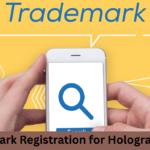In today’s digital age, where innovation drives brand recognition, hologram marks have emerged as a unique and powerful form of trademark. A hologram mark, which is a three-dimensional visual representation that changes appearance when viewed from different angles, offers an innovative way for businesses to distinguish their products or services in the marketplace. As these marks become increasingly popular, understanding the process and benefits of trademark registration for hologram mark is essential for businesses looking to protect their intellectual property.
What is a Hologram Mark?
A hologram mark is a distinctive sign that can be seen in three dimensions and shifts visually depending on the angle of the viewer’s perspective. These marks are created using advanced technology, which allows them to have dynamic qualities that are not possible with traditional two-dimensional marks. Common examples of hologram marks include holographic logos, labels, or packaging that incorporate visual elements capable of creating a stunning effect of depth, light, and movement. Due to their complexity and uniqueness, hologram marks provide brands with an effective way to stand out in a competitive market.
Why Register a Hologram Mark?
Trademark registration offers several advantages, particularly for innovative forms of branding like hologram marks. By registering a hologram mark, businesses secure exclusive rights to their distinctive design, preventing others from using a similar visual element that might confuse consumers. This legal protection extends to trademark infringement cases, where unauthorized use of the hologram can be stopped through legal recourse. Furthermore, trademark registration provides a powerful tool for brand recognition, as the mark can be used to signify the source of goods or services and build a unique identity in the market.
The Trademark Registration Process for Hologram Marks
Registering a hologram mark follows a similar process to traditional trademark registration, though it may require additional considerations. The first step is to ensure that the hologram mark is distinctive and capable of distinguishing the goods or services of the applicant from those of competitors. This can be more challenging for hologram marks, as the uniqueness of the design needs to be clearly understood and visualized in a way that meets trademark standards.
Once the distinctiveness of the mark is established, the applicant must submit the hologram mark to the relevant intellectual property office. This involves providing visual representations that accurately capture the dynamic nature of the hologram. Since hologram marks are three-dimensional and constantly changing, it can be difficult to convey their appearance through static images, which might require the submission of video clips or detailed descriptions to fully represent the mark. In some jurisdictions, applicants may also be asked to provide evidence of how the mark is used in commerce.
Challenges in Hologram Mark Registration
Despite the growing popularity of hologram marks, the registration process can present several challenges. One key hurdle is the requirement for clarity in describing how the mark functions. As holograms are inherently dynamic, applicants may face difficulties in proving that the mark is not merely decorative but serves a functional role in identifying the brand. Intellectual property offices must be convinced that the hologram’s visual qualities are distinctive enough to function as a trademark.
Additionally, some countries may have specific restrictions on the types of marks that can be registered, especially when it comes to unconventional signs like holograms. The mark must not only be visually distinctive but also meet the requirements of the jurisdiction in which it is being filed. In some cases, applicants may need to prove that their hologram mark has acquired distinctiveness through extensive use or consumer recognition.
The Global Landscape of Hologram Mark Registration
As the global market continues to evolve, the recognition of hologram marks is becoming more widespread. Countries around the world are beginning to accommodate these marks within their trademark systems, although the extent of their acceptance varies. Some jurisdictions, like the European Union, have been more open to registering unconventional marks, including holograms, while others may still be catching up to this innovative form of trademark protection.
For businesses looking to expand internationally, understanding how hologram marks are treated in different regions is essential. It is important for brands to consult with trademark experts who are familiar with the nuances of international trademark law and the specific requirements for hologram mark registration in each territory.
The Future of Hologram Marks in Trademark Law
As technology advances, the role of hologram marks in branding is expected to grow. The increasing use of holograms in advertising, product packaging, and digital platforms presents new opportunities for brands to create unforgettable visual identities. The future of trademark law will likely see more adaptation to accommodate these evolving forms of intellectual property.
In the coming years, it is anticipated that more businesses will seek trademark registration for hologram marks to protect their innovative branding efforts. As hologram technology becomes more accessible and affordable, it is likely that the market will see an influx of new holographic designs and trademarks, which will further cement their place as a key element of modern brand protection strategies.
In conclusion, trademark registration for hologram marks offers significant benefits in protecting the uniqueness of a brand’s identity in a dynamic and ever-evolving marketplace. As businesses continue to embrace cutting-edge technology to engage consumers, understanding how to register and protect these innovative trademarks will be crucial for staying ahead of the competition and safeguarding brand equity.

